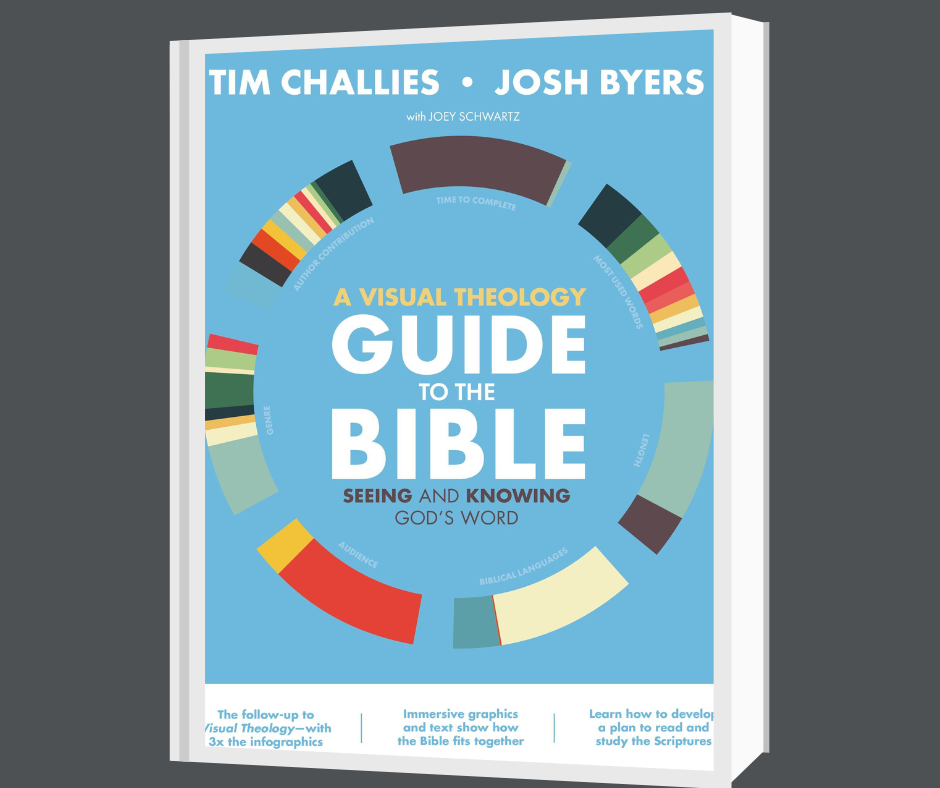Book Reviews
A Visual Theology Guide to the Bible: Seeing and Knowing God’s Word, by Tim Challies and Josh Byers | Review by Rosa Byler

No one would dispute the biblical illiteracy of our culture at large, but how many Christians share that ignorance? Barna Group polls, among others, suggest that reverence for the Bible does not always result in reading it regularly. Confusion about how the various books fit together is a common problem, as well as a general feeling of uncertainty about some parts of the Old Testament. As the subtitle indicates, A Visual Theology Guide to the Bible provides help for those who wish they knew God’s Word better.
The book is divided into three sections. “Trusting the Bible” shows some of the Bible’s effects on history before introducing it as two testaments, sixty-six books, and eight genres, but one big story. Author Tim Challies describes how the books were written, collected, and preserved, giving the Bible “more evidence for its integrity than any other ancient book.” (30) Its unique qualities can be summarized with the acronym SCAN: the sufficiency, clarity, authority, and necessity of Scripture. Aided by illustrator Josh Byers’ colorful infographics, Challies explains these traditional theological terms in simple language.
Part 2 presents the why and how of “Studying the Bible.” This part was my favorite. Habitual reading of the Bible increases our knowledge of God and our joy in Him. It provides material for prayer and strengthens us against temptation, among other benefits. The authors recommend reading the Bible through at least once a year, “a very small commitment compared to what we typically give our time to.” (85) A few statistics support this claim, followed by simple instructions that begin with “make time.”
Challies makes it clear that right motivation is crucial. Reading with “humility and dependence upon God” will help us to avoid the error of the Pharisees, who studied, memorized, and obeyed the Law yet missed Jesus. The Bible can be misconstrued as a rule book, a self-help manual, or a justification for political agenda instead of the way to knowing God. (75)
The four-step study process for any book of the Bible is to observe, interpret, apply, and memorize. We observe by noticing and asking questions; we interpret by examining the literary and historical contexts and the genre; we apply by allowing the Word to shape our minds, affections, and actions. No one gets a free pass on memorization—“the main obstacle is not ability but priority.” (98)
Part 3 is the longest section of the material, an overview of the larger divisions of Scripture. From the Fall illustrating the need for Jesus through the Law laying a foundation for Him and the kings and prophets preparing the way, the whole Bible is the story of God’s plan of salvation through faith in Jesus. Matthew connects Jesus to Abraham in the “begats”; the early church fleshes out the reality of Jews and Gentiles made one in Christ. The apostles’ letters exhort and comfort Christians, and Revelation shows Christ’s kingdom consummated at His return.
This book makes an excellent case for biblical literacy, presenting Bible reading as necessary, doable, and appealing. For the visually oriented, Byers’ infographics illustrate concepts far better than typical textbook line graphs and bar charts. For word enthusiasts, the well-written text is fully able to stand alone (some readers may find the diagrams almost an intrusion). Even the book’s appearance indicates readability, with smooth, shiny, well-arranged pages and friendly-sized print. Though details on individual books are limited, the general effect is warm encouragement to read, study, and become more conversant with the whole story of the Bible. Highly recommended for any Christian, especially for teachers and influencers of the young.